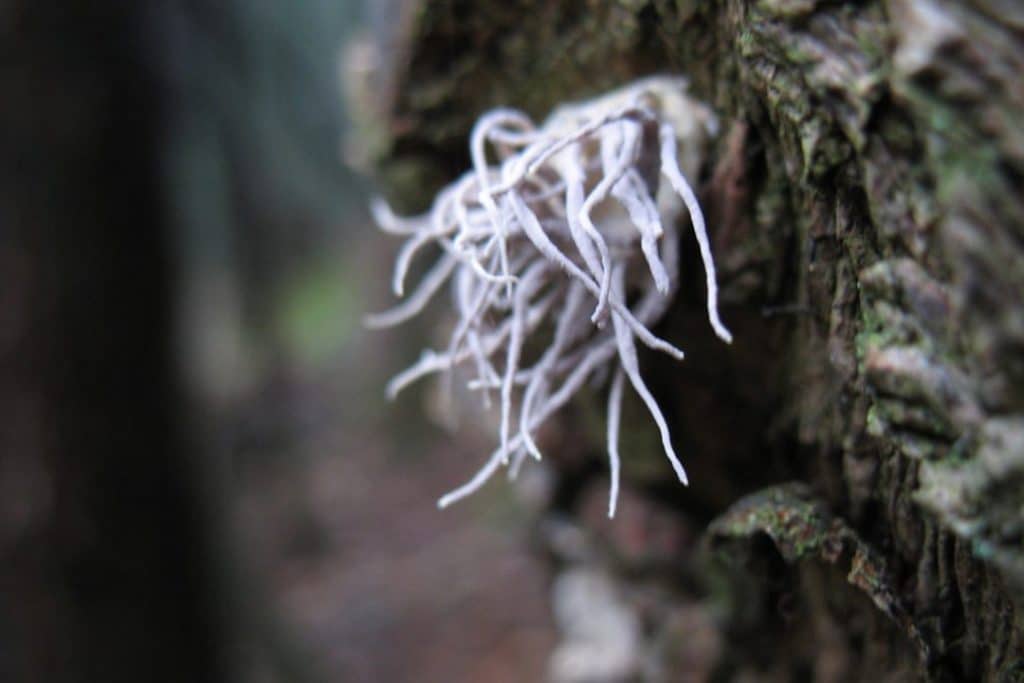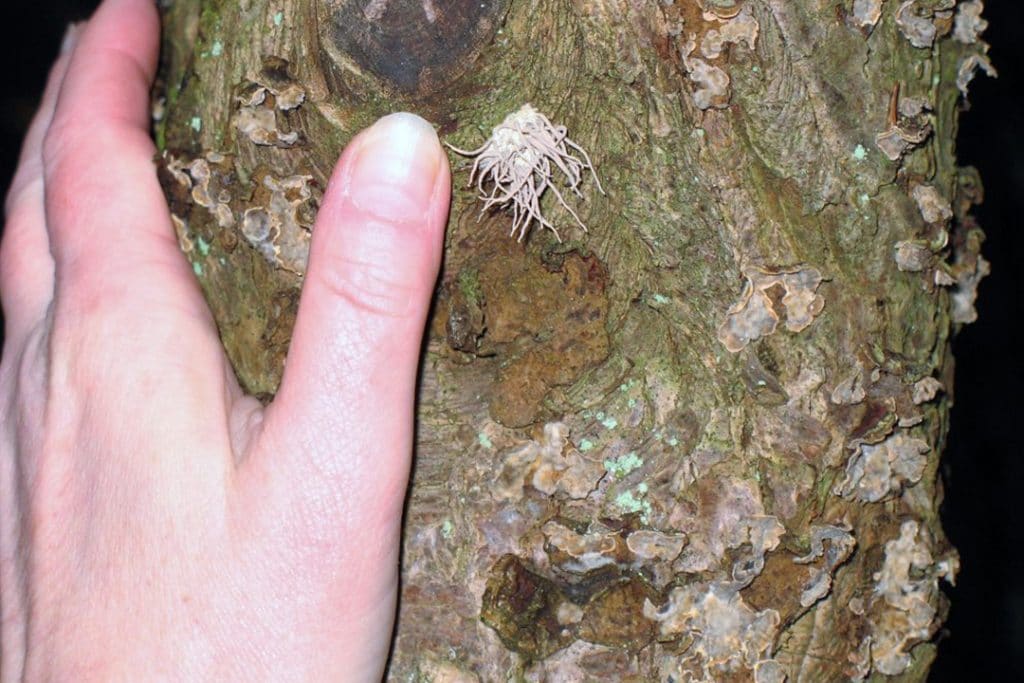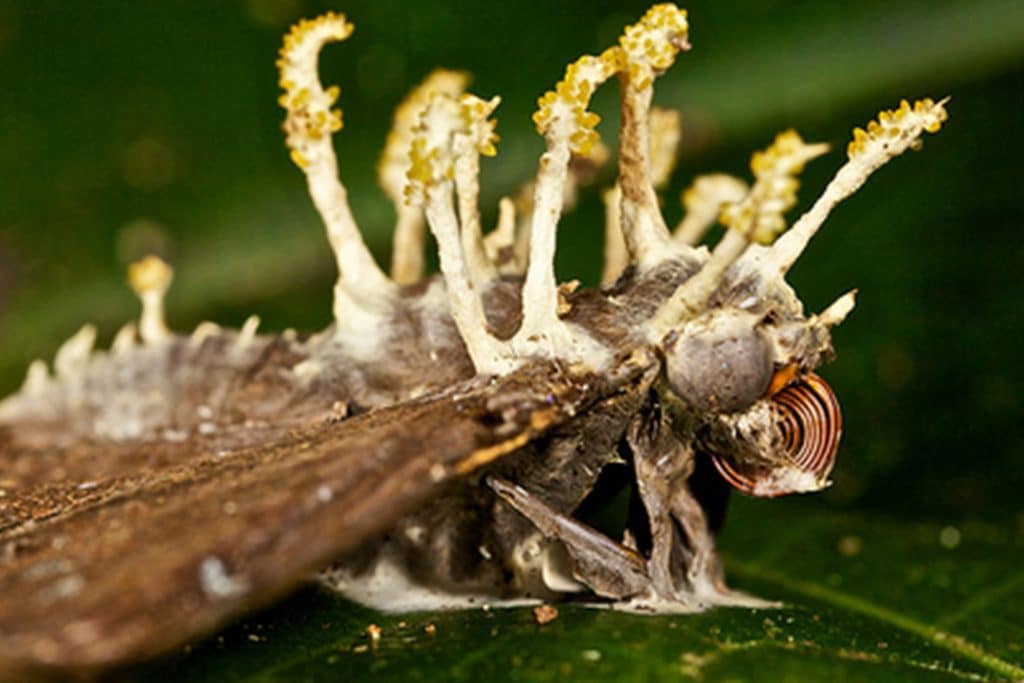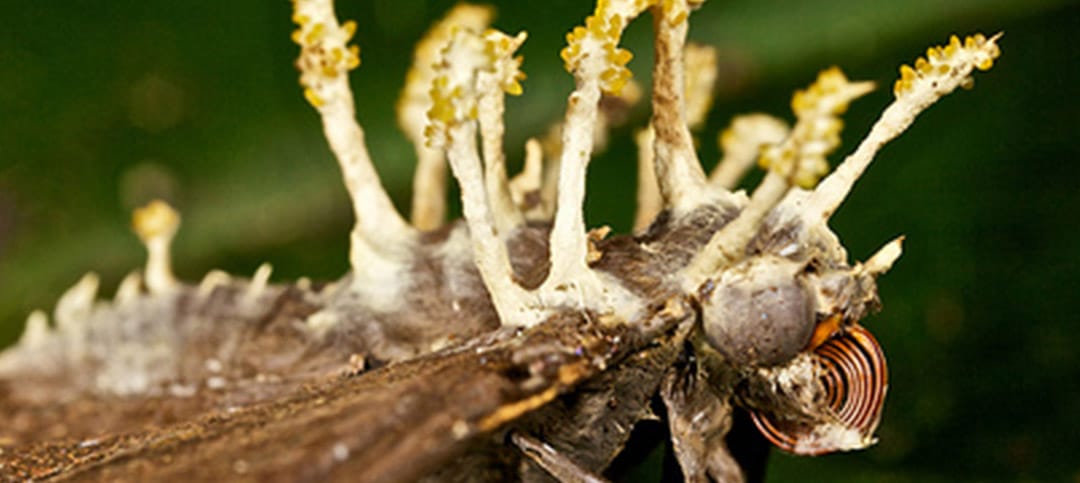Essay and photos by Peary Stafford
It’s January… and there’s precious little nature to study in Steep Rock. Few birds, no insects and for sure no flowering plants. But there’s always something and these desolate winter days, BK and I (OK, mostly I) have taken to investigating the fungal life of our beloved Land Trust. This particular day, driven by cabin fever, we settled upon fungus for a reason to go walking in the nasty, misty weather. Parking at the Hidden Valley Preserve, we walked in on the Bee Brook side, taking photos and collecting various forms of mostly woody shelf fungus on the way; a couple of amateur mycologists hoping to make an ID or two back home with the help of our field guides. Working our way out to the bridge, we crossed the Shepaug and were about to return when I spotted a tree covered with some small species of shelf fungus. Wondering what it might be and if it was different from all the other similar things we had already seen, I noticed something really different; something that looked like the back end of a tiny white squid sticking out from the trunk.


I must admit that this next bit falls straight into the category of a little knowledge is a dangerous thing, for I immediately proclaimed “Coral Fungus!” believing it to be something I’d read about and seen pictures of in the field guides and thought looked pretty cool. Fascinated, we took a number of photos, then continued our walk back out toward Route 47, checking tree trunks, stumps and fallen logs as we went. A little ways down the path we saw a man walking toward us carrying what was obviously some pretty serious camera equipment. Curious as to what someone else was doing out there on this hideous day, I asked him what he was photographing. He said that he worked for the Republican-American and needed some nature pictures for the supplement Country Life. In return, he asked what we were up to and I replied that we were looking at fungus and showed him some of the cool stuff I had in my pockets. Bemused, he exclaimed that this was the first time that someone had told him that he had a pocket full of fungus and was actually proud of it!
Feeling suddenly a bit sheepish, I managed that back down the trail a little ways there was a really neat little thing called a coral fungus and that he should take a picture of that for his nature shot. He nodded dubiously; we went back down the trail where I showed him the tree, and he took some photos of the little organism. He also snapped one or two of us as we examined the odd little thing and the photos in the paper a few weeks later gave rise to comments about my “Elmer Fudd hat” as well as the inevitable fungus jokes.
Inevitably, when we got home and I looked in the books, I was horrified to learn that my coral fungus identification wasn’t even close. While it looks superficially similar, a species with the neat name White Worm Coral grows out of the ground, not tree trunks, and is fragile as fine china, while ours was soft and pliable. Visions of bad identifications printed in newspapers and attributed to me started flashing through my brain and I immediately emailed Greg Hanisek (who also works at the Republican-American) to head off our photographer and to get his advice as to what this now mystery form of life might be. If Greg could stop my misidentification from being printed, at least I would be able to go to bed that night knowing that I wouldn’t be the laughing stock of all the many mycophiles within the range of the paper.
It wasn’t too long before I got back a copy of my email that Greg had forwarded to a man named Bill Yule – a past president of the CT Mycological Society – asking for help. This man’s so into fungus that he uses the email address Bolete Bill – Bolete being a family of mushrooms.
The next morning there was a response from Bolete Bill and it seems he had a pretty good idea of what the item in question was. His “wild guess” as he put it, was
“one of the Cordyceps [genus] that attacks moths and entombs them. Sometimes the moth emerges from a cocoon but can’t fly and just slowly dies under bark…here’s an attached picture of one that attacks the Copper Underwing [a kind of moth]…as the mushroom continues to grow the moth more or less disappears and you’re left with a mass of squiggly fungal arms in a clump…kind of what you see there in the pic…”

Well, that was enough to pique my interest! Off I went to try to find out more about Mr. Cordyceps on the Internet. Googling the word did little to help, as apparently this fungus is also used in some funky herbal remedies for God-knows-what, and all I got were a lot of commercial pages about stuff that didn’t sound quite on the up-and-up. One page claimed that ingesting it would: stimulate the immune system; — cure sexual dysfunction in men; — maximize body oxygen uptake; — build muscles; — improve kidney, liver and lung functioning; — provide anti-aging effect… and to boot: The list of what is stated is not complete. While I wasn’t quite ready to run back to the tree and wolf it down, I certainly was impressed with its purported beneficial effects. On the other hand, I’m not sure I want to see what kind of spam I’m going to get as a result of visiting those pages!
Eventually I did find a web page – MushroomExpert.com – that had a ton of information about this form, including this little tidbit: there’s a congener – a member of the same genus – of our Cordyceps down in Costa Rica that is even more devious than ours. It’s unfortunate prey is a type of ant that upon ingesting a spore of the fungus ends up having its brain rewired by the evil thing. This rearrangement of synapses causes the ant to climb to the top of a tree in the rainforest and attach itself to the uppermost leaves, whereupon the fungus promptly sprouts from the head of the ant like the monster in the movie Alien. It then merrily releases its spores into the jungle breezes. I mean, I get evolution and all that, but fungus isn’t exactly a higher life form. How in the world did it figure out how to do that?
Whew! This was getting serious and I really needed to know if our little squid butt was actually one of these fungi. So on another nasty day – this one really cold – I dragged BK back out and we went back to the tree. It took some doing to find our friend this time, as the cold (I presume) had caused the fungus to retract somewhat, turning it a lot grayer and smaller in the process. But find it we did, and with a couple of pokes with a Swiss Army Knife it was in a ziplock bag and headed for home. Lunch at The Pantry intervened and was fraught with the anticipation of discovery.
Once home I searched frantically for the hand lens that everyone seems to want to put anywhere but where I want it to be. I finally found it (on the mantle where I had undoubtedly left it), walked to a shaft of sunlight coming through the kitchen window and peered through the lens at the fungus in my hand. Like the man said; squiggly fungus arms. But way down at the bottom below the fungal arms (sounds remarkably like an English pub) covered in the white crust that formed the base of the piece I’d prized out, were two tubular protrusions that could just be the lower portion of an insect’s antennae. There also seemed to be mouthparts between the antennae and on the other side of the clump a few stumps were in just the right places for legs. It took little more inspection to determine that indeed, the thing the fungus was attached to was the well-decomposed remains of an insect!
Cool! It really was an insect-eating fungus! My curiosity in high gear, I had to learn more, and my instincts told me that Bolete Bill was my man.
Peary Stafford
A half a day and a couple of emails later a virtual tome on the ecology of Cordyceps was staring at me from my computer screen. It seems that this little organism holds no end of surprises. Leaving out all the anamorphs and teleomorphs and Ascomycetes that peppered his scientific discussion, the gist of what Bill told me was this: These things are so little understood that biologists have actually placed them in an “Ain’t got a clue” category. Apparently there are two phases of this particular type of fungus, one that’s capable of reproducing and one that can’t, and depending upon some poorly understood divine scheme sometimes the one comes up and sometimes it’s the other. Problem is, nobody knows which of the one form goes with the other, as they look entirely different. As a result, the mycologists have a whole bunch of sexual fungi and a whole bunch of asexual fungi all stuck in this category just waiting for some molecular biologist to fit them together. It’s sort of like the old school tests; take one from column A and match it with one from column B.
Here are some more of Bill’s words about the ecology of this primitive form:
- This whole puzzle is kind of analogous to a tadpole and a frog. Suppose a tadpole had one scientific name, Squiggly squirmorum and a frog had another, Hoppity jumpalotta and no one suspected the two were connected. Tadpoles don’t reproduce sexually but suppose they could clone themselves to make more tadpoles. So herpetologists went through life thinking hey there’s these cool animals called tadpoles that only clone themselves and they live in the water, etc. Then one day some primitive biologist brought a particular tadpole home and it turned into a particular frog. Squiggly squimorum was actually the asexual stage of Hoppity jumpalotta. the frog. Sooooo Squiggly is the anamorph and Hoppity is the teleomorph and all considered together as two different morphological expression of the same organism is the holomorph.
- I kind of get it now, I think. Maybe. Complex, yes; and wonderful. But so intricate and bewildering and it’s just one more example of the incredible things going on under our noses at Steep Rock. Just as good, the Connecticut Valley Mycological Society has been making annual forays at Steep Rock for at least 15 years and they haven’t yet recorded this species (Cordyceps tubularis), so it’s a new one for the Steep Rock Fungus List! They’d never seen the huge soccer ball-sized puffball I found at Macricostas last summer either, but that’s a whole other story…


